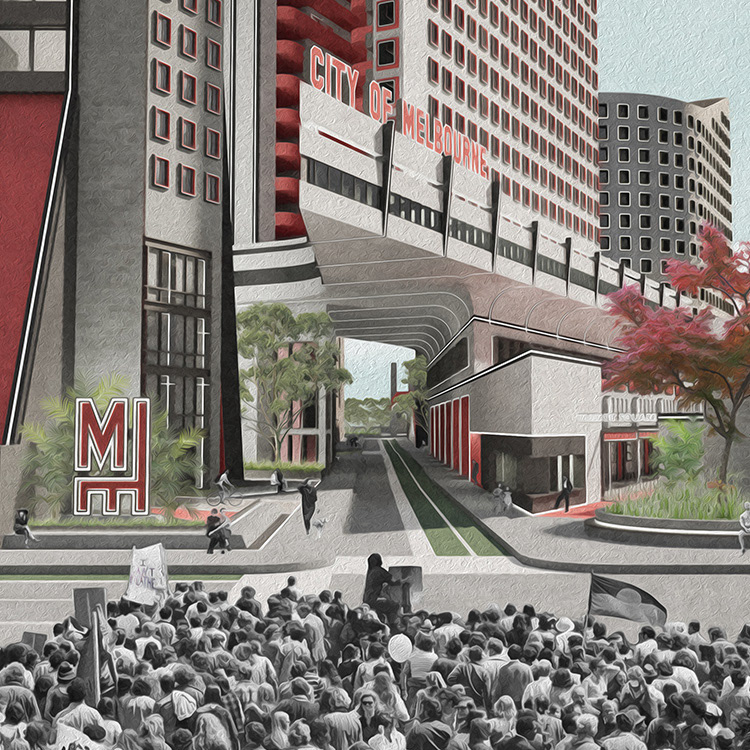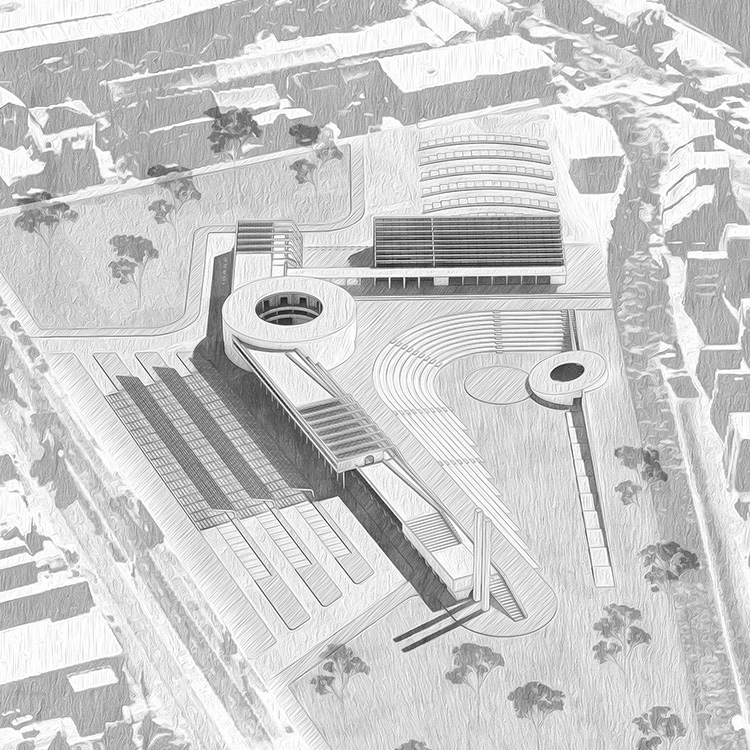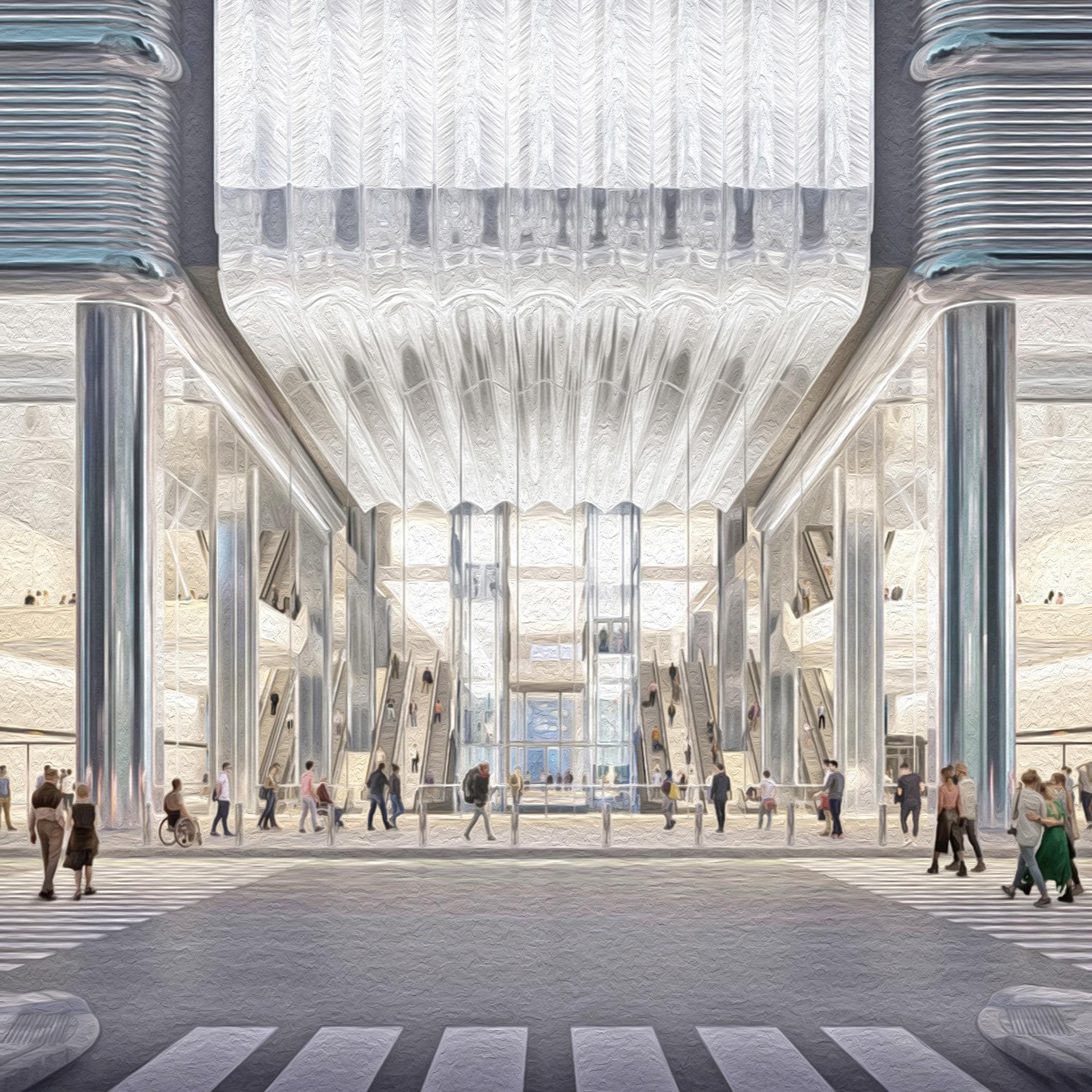2019 Master of Architecture Project
Studio 'Nullius Filius' by Lucy McRae
Studio 'Nullius Filius' by Lucy McRae
Directed by Alessandro Castiglioni + Max Kochinke
Performed by River Gallo
Music by David August
Performed by River Gallo
Music by David August
SCI_ARC
PROJECT SYNOPSIS
‘Homo Postgenus’ speculates on a near-future reality where genetic engineering and postgender theories are coupled to create a new species of humans unconstrained by sex and gender.
The patriarchal systems embedded within Information Technology and Biotechnology allow grim speculations on the future of equality.
We are entering an era of Dataism, where we increasingly rely on technologies such as Artificial Intelligence to make decisions for us.
The gender bias of these technologies, coupled with our dependence on them, will inevitably lead to hypermasculine behaviours in social and political relationships, a virilization that could cause geopolitical instability.
Suppose international politics are no longer about bluffs, threats, and corruption but rather about pre-determined scripts with a cause and a consequence.
In that case, a third global conflict could not be fiction anymore. A Dataist political system maneuverer by male politicians and engineered by male coders will inevitably cause violence and conflict.
We are entering an era of Dataism, where we increasingly rely on technologies such as Artificial Intelligence to make decisions for us.
The gender bias of these technologies, coupled with our dependence on them, will inevitably lead to hypermasculine behaviours in social and political relationships, a virilization that could cause geopolitical instability.
Suppose international politics are no longer about bluffs, threats, and corruption but rather about pre-determined scripts with a cause and a consequence.
In that case, a third global conflict could not be fiction anymore. A Dataist political system maneuverer by male politicians and engineered by male coders will inevitably cause violence and conflict.
‘Homo Postgenus’ wants to shed light on the gender issue of Artificial Intelligence and to advocate for an unbiased design of the codes that will drive decision-making in the near future.
How can we advocate for the impartiality of machines to replace human decision-making when machines are predominantly engineered by men?
Could gene editing technologies be employed to design inequality out of the human experience?
How can we advocate for the impartiality of machines to replace human decision-making when machines are predominantly engineered by men?
Could gene editing technologies be employed to design inequality out of the human experience?
We speculate on a collaborative effort between future Dataist politics and CRISPR Biotechnology to artificially breed and design a generation of postgender Homo Sapiens in charge of Artificial Intelligence, the Homo Postgenus.
Created in artificial embryos with prime genetic material, their 23rd chromosome, which determines biological sex, would be edited to become neutral.
Raised within a de-nationalized context, the Homo Postgenus would develop an unbiased epigenome and eventually take charge of global data and Artificial Intelligence under a global agreement.
Created in artificial embryos with prime genetic material, their 23rd chromosome, which determines biological sex, would be edited to become neutral.
Raised within a de-nationalized context, the Homo Postgenus would develop an unbiased epigenome and eventually take charge of global data and Artificial Intelligence under a global agreement.
In the speculative world of ‘Homo Postgenus’, these propositions unfold as a failed experiment.
The impartiality of the postgender guardians of Artificial Intelligence causes a collapse of capitalism and the global market.
Consequently, the Homo Postgenus are dismissed, imprisoned, and left with their unusual machine in isolation.
Designed and constructed by the Homo Postgenus, the machine allows a series of rituals to be performed.
A choreography of movements activates different parts of the machine and reveals its purpose.
Intimacy and empathy between the body and the object create a relationship of reliance.
The Homo Postgenus depends on the machine to define their identity, and the machine depends on their body to be understood.
The impartiality of the postgender guardians of Artificial Intelligence causes a collapse of capitalism and the global market.
Consequently, the Homo Postgenus are dismissed, imprisoned, and left with their unusual machine in isolation.
Designed and constructed by the Homo Postgenus, the machine allows a series of rituals to be performed.
A choreography of movements activates different parts of the machine and reveals its purpose.
Intimacy and empathy between the body and the object create a relationship of reliance.
The Homo Postgenus depends on the machine to define their identity, and the machine depends on their body to be understood.
‘Homo Postgenus’ asks,
Can we achieve equality in a world where gender is strictly determined by biological differences?
And should we be preoccupied with the male domination of the infotech and biotech industries?
Most importantly, could Postgenderism play a role in the improvement of these conditions?
Can we achieve equality in a world where gender is strictly determined by biological differences?
And should we be preoccupied with the male domination of the infotech and biotech industries?
Most importantly, could Postgenderism play a role in the improvement of these conditions?
Work in Progress Exhibition at SCI-Arc
Curated by Alessandro Castiglioni and Max Kochinke
Photography by Luka Booth
Model Karis Wilde
Model Karis Wilde
POSTGENDER MACHINE
The bathroom and dressing room have traditionally played a very important role in constructing the gender binary throughout history.
In the public realm, these spaces divide the two sexes, and in the domestic setting, they are where we are in touch the most with our gendered bodies.
What if these identity-building spaces were to become a machine?
How would this machine be used by a postgender human?
How would the grooming rituals that construct femininity and masculinity shift?
Defining gender and identity through the everyday rituals of appearance, this machine is understood as the postgender monument of the future.
It is built by the Homo Postgenus for the Homo Postgenus.
Analysis of its components allows us to understand the postgender body and the construction of a postgendered identity.
In the public realm, these spaces divide the two sexes, and in the domestic setting, they are where we are in touch the most with our gendered bodies.
What if these identity-building spaces were to become a machine?
How would this machine be used by a postgender human?
How would the grooming rituals that construct femininity and masculinity shift?
Defining gender and identity through the everyday rituals of appearance, this machine is understood as the postgender monument of the future.
It is built by the Homo Postgenus for the Homo Postgenus.
Analysis of its components allows us to understand the postgender body and the construction of a postgendered identity.
HOMO POSTGENUS
Speculations around novel genetic engineering technologies such as CRISPR caused many to question what it means to be human and interrogate the boundaries of our species.
Will CRISPR become a solely medical tool, or will we enhance our bodies to reach ideal expectations of beauty and performance?
If we could edit out physical features that make us unconventional, would we risk falling back into stereotypical ideas of masculinity and femininity?
The Homo Postgenus was initially designed to eradicate bias from the biology of decision-making.
However, their existence soon caused debate around beauty as much as ethics.
Will CRISPR become a solely medical tool, or will we enhance our bodies to reach ideal expectations of beauty and performance?
If we could edit out physical features that make us unconventional, would we risk falling back into stereotypical ideas of masculinity and femininity?
The Homo Postgenus was initially designed to eradicate bias from the biology of decision-making.
However, their existence soon caused debate around beauty as much as ethics.
SMILE RITUAL
Grooming, washing, and makeup are everyday rituals that boost our self-confidence and allow us to adhere to cultural and societal norms.
The most minimal adjustment to our appearance can have a much more significant impact on our perception of self.
The Homo Postgenus' smile ritual consists of a series of movements that they go through daily to change their perception of the self.
Two rotating and adjustable circular plates trap the head within a soft cloud of makeup powder and allow the Homo Postgenus to start the day in a happy mood.
The most minimal adjustment to our appearance can have a much more significant impact on our perception of self.
The Homo Postgenus' smile ritual consists of a series of movements that they go through daily to change their perception of the self.
Two rotating and adjustable circular plates trap the head within a soft cloud of makeup powder and allow the Homo Postgenus to start the day in a happy mood.
SMOKE RITUAL
Smoking rituals can be traced through the history of most cultures across the world.
Whether it was about transcendence, purification, magic, or alchemy, smoke is a recurrent element in ceremonial and spiritual practices.
Whereas many identity-building rituals involve body alteration, psychotropic smoking rituals can be understood as operations to augment the human mind.
Rituals of this sort allowed many cultures to transcend subjectivity and experience continuity with the objective world.
The Postgender machine accommodates a smoking ritual that the Homo Postgenus enacts to draw out subjective and biased thoughts.
By accessing select global data before the practice, they can channel their mind’s travels to understand unknown contexts.
Whether it was about transcendence, purification, magic, or alchemy, smoke is a recurrent element in ceremonial and spiritual practices.
Whereas many identity-building rituals involve body alteration, psychotropic smoking rituals can be understood as operations to augment the human mind.
Rituals of this sort allowed many cultures to transcend subjectivity and experience continuity with the objective world.
The Postgender machine accommodates a smoking ritual that the Homo Postgenus enacts to draw out subjective and biased thoughts.
By accessing select global data before the practice, they can channel their mind’s travels to understand unknown contexts.
HAIR RITUAL
The length and styling of human hair have traditionally been instrumental in the construction of gender.
Additionally, the location and presence of body hair in different parts of the human body have a strong weight in our definition of masculinity and femininity.
But what if we were designed to grow hair of any length in any part of the body?
The hair ritual consists of the spinning of the post-gender hair wheel to determine a selection of the hair for the day.
Based on the tasks for the day, the Homo Postgenus determines where to locate the selected hair on the body.
Additionally, the location and presence of body hair in different parts of the human body have a strong weight in our definition of masculinity and femininity.
But what if we were designed to grow hair of any length in any part of the body?
The hair ritual consists of the spinning of the post-gender hair wheel to determine a selection of the hair for the day.
Based on the tasks for the day, the Homo Postgenus determines where to locate the selected hair on the body.
COLOR RITUAL
Face and body painting plays a significant role in the construction of gender in many different cultures.
From colour selection to location and application, makeup hides a ritualistic aspect that allows speculation on its role within a postgender context.
Can existing gendered objects associated with makeup be subverted to re-understand the process of colouring in a nongendered way?
The bodystick arm of the postgender machine allows the Homo Postgenus to apply colour to their face and body and undergo an ultraviolet light treatment.
The pattern of coloration seems to shift according to the Homo Postgenus' task for the day.
From colour selection to location and application, makeup hides a ritualistic aspect that allows speculation on its role within a postgender context.
Can existing gendered objects associated with makeup be subverted to re-understand the process of colouring in a nongendered way?
The bodystick arm of the postgender machine allows the Homo Postgenus to apply colour to their face and body and undergo an ultraviolet light treatment.
The pattern of coloration seems to shift according to the Homo Postgenus' task for the day.
SKIN RITUAL
Fashion, make-up, grooming, and plastic surgery allow us to alter the appearance of the human body in the belief that we can consequently express our inner selves.
While these methods accommodate change over time, there are certain features that we cannot alter.
Skin, like sex, is something we are born with that causes us to label the human body in racial categories.
As a consequence of colonialism, our outer layer can often determine privilege or disadvantage.
Would the possibility of shifting skin tones allow humans to be more empathetic towards each other?
The skin ritual enables the Homo Postgenus to change skin coloration according to what tasks they need to perform.
An alchemical process of ambiguous liquids and pigmentation shifts the body's skin, allowing the Homo Postgenus to connect to the AI scripts' particular audience.
While these methods accommodate change over time, there are certain features that we cannot alter.
Skin, like sex, is something we are born with that causes us to label the human body in racial categories.
As a consequence of colonialism, our outer layer can often determine privilege or disadvantage.
Would the possibility of shifting skin tones allow humans to be more empathetic towards each other?
The skin ritual enables the Homo Postgenus to change skin coloration according to what tasks they need to perform.
An alchemical process of ambiguous liquids and pigmentation shifts the body's skin, allowing the Homo Postgenus to connect to the AI scripts' particular audience.






